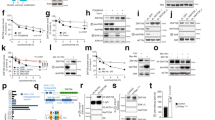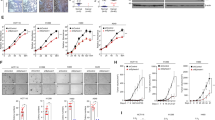Abstract
Ras acts with other proteins to induce neoplasia. By itself, however, strong Ras signaling can suppress proliferation of normal cells. In primary epidermal cells, we found that oncogenic Ras transiently decreases cyclin-dependent kinase (CDK) 4 expression in association with cell cycle arrest in G1 phase. CDK4 co-expression circumvents Ras growth suppression and induces invasive human neoplasia resembling squamous cell carcinoma. Tumorigenesis is dependent on CDK4 kinase function, with cyclin D1 required but not sufficient for this process. In facilitating escape from G1 growth restraints, Ras and CDK4 alter the composition of cyclin D and cyclin E complexes and promote resistance to growth inhibition by INK4 cyclin-dependent kinase inhibitors. These data identify a new role for oncogenic Ras in CDK4 regulation and highlight the functional importance of CDK4 suppression in preventing uncontrolled growth.
This is a preview of subscription content, access via your institution
Access options
Subscribe to this journal
Receive 12 print issues and online access
$209.00 per year
only $17.42 per issue
Buy this article
- Purchase on Springer Link
- Instant access to full article PDF
Prices may be subject to local taxes which are calculated during checkout





Similar content being viewed by others
References
Evan, G.I. & Vousden, K.H. Proliferation, cell cycle and apoptosis in cancer. Nature 411, 342–348 (2001).
Ewen, M.E. Relationship between Ras pathways and cell cycle control. Prog. Cell Cycle Res. 4, 1–17 (2000).
Adnane, J. et al. Loss of p21WAF1/CIP1 accelerates Ras oncogenesis in a transgenic/knockout mammary cancer model. Oncogene 19, 5338–5347 (2000).
Peeper, D.S., Dannenberg, J.H., Douma, S., te Riele, H. & Bernards, R. Escape from premature senescence is not sufficient for oncogenic transformation by Ras. Nature Cell Biol. 3, 198–203 (2001).
Elenbaas, B. et al. Human breast cancer cells generated by oncogenic transformation of primary mammary epithelial cells. Genes Dev. 15, 50–65 (2001).
Hahn, W.C. et al. Creation of human tumor cells with defined genetic elements. Nature 400, 464–468 (1999).
Koontongkaew, S., Chareonkit, L., Chanvitan, A. & Amornphimoltham, P. Alterations of p53, pRb, cyclin D(1) and cdk4 in human oral and pharyngeal squamous cell carcinomas. Oral Oncol. 36, 334–339 (2000).
Matsumoto, M., Furihata, M., Ishikawa, T., Ohtsuki, Y. & Ogoshi, S. Comparison of deregulated expression of cyclin D1 and cyclin E with that of cyclin-dependent kinase 4 (CDK4) and CDK2 in human oesophageal squamous cell carcinoma. Br. J. Cancer 80, 256–261 (1999).
Sui, L. et al. Inverse expression of Cdk4 and p16 in epithelial ovarian tumors. Gynecol. Oncol. 79, 230–237 (2000).
Miller, D.L. & Weinstock, M.A. Nonmelanoma skin cancer in the United States: incidence. J. Am. Acad. Dermatol. 30, 774–778 (1994).
Pierceall, W.E., Goldberg, L.H., Tainsky, M.A., Mukhopadhyay, T. & Ananthaswamy, H.N. Ras gene mutation and amplification in human nonmelanoma skin cancers. Mol. Carcinog. 4, 196–202 (1991).
Berking, C. et al. Photocarcinogenesis in human adult skin grafts. Carcinogenesis 23, 181–187 (2002).
Yuspa, S.H. The pathogenesis of squamous cell cancer: lessons learned from studies of skin carcinogenesis—thirty-third G. H.A. Clowes Memorial Award Lecture. Cancer Res. 54, 1178–1189 (1994).
Shields, J.M., Pruitt, K., McFall, A., Shaub, A. & Der, C.J. Understanding Ras: 'it ain't over 'til it's over'. Trends Cell Biol. 10, 147–154 (2000).
Serrano, M., Lin, A.W., McCurrach, M.E., Beach, D. & Lowe, S.W. Oncogenic ras provokes premature cell senescence associated with accumulation of p53 and p16INK4a. Cell 88, 593–602 (1997).
Dajee, M., Tarutani, M., Deng, H., Cai, T. & Khavari, P.A. Epidermal Ras blockade demonstrates spatially localized Ras promotion of proliferation and inhibition of differentiation. Oncogene 21, 1527–1538 (2002).
Inouye, K., Mizutani, S., Koide, H. & Kaziro, Y. Formation of the Ras dimer is essential for Raf-1 activation. J. Biol. Chem. 275, 3737–3740 (2000).
Choi, K.S. et al. Cdc2 and Cdk2 kinase activated by transforming growth factor-β1 trigger apoptosis through the phosphorylation of retinoblastoma protein in FaO hepatoma cells. J. Biol. Chem. 274, 31775–31783 (1999).
Robbins, P.B. et al. In vivo restoration of laminin 5 β3 expression and function in junctional epidermolysis bullosa. Proc. Natl. Acad. Sci USA 98, 5193–5198 (2001).
Eisma, R.J., Spiro, J.D. & Kreutzer, D.L. Vascular endothelial growth factor expression in head and neck squamous cell carcinoma. Am. J. Surg. 174, 513–517 (1997).
Koseki, S. et al. An immunohistochemical study of E-cadherin expression in human squamous cell carcinoma of the skin: relationship between decreased expression of E-cadherin in the primary lesion and regional lymph node metastasis. J. Dermatol. 26, 416–422 (1999).
Tsukifuji, R., Tagawa, K., Hatamochi, A. & Shinkai, H. Expression of matrix metalloproteinase-1, -2 and -3 in squamous cell carcinoma and actinic keratosis. Br. J. Cancer 80, 1087–1091 (1999).
Skotzko, M., Wu, L., Anderson, W.F., Gordon, E.M. & Hall, F.L. Retroviral vector-mediated gene transfer of antisense cyclin G1 (CYCG1). Cancer Res. 55, 5493–5498 (1995).
Robles, A.I. et al. Reduced skin tumor development in cyclin D1-deficient mice highlights the oncogenic ras pathway in vivo. Genes Dev. 12, 2469–2474 (1998).
Yu, Q., Geng, Y. & Sicinski, P. Specific protection against breast cancers by cyclin D1 ablation. Nature 411, 1017–1021. (2001).
Wang, H., Goode, T., Iakova, P., Albrecht, J.H. & Timchenko, N.A. C/EBPα triggers proteasome-dependent degradation of cdk4 during growth arrest. EMBO J. 21, 930–941 (2002).
Hahn, W.C. et al. Enumeration of the simian virus 40 early region elements necessary for human cell transformation. Mol. Cell Biol. 22, 2111–2123 (2002).
Benjamin, T. & Vogt, P.K. Cell transformation by viruses. in Virology (eds Fields, B.N. & Knipe, D.M.) 317–367 (Raven Press, New York, 1990).
Proby, C.M. et al. Spontaneous keratinocyte cell lines representing early and advanced stages of malignant transformation of the epidermis. Exp. Dermatol. 9, 104–117 (2000).
Wick, M., Zubov, D. & Hagen, G. Genomic organization and promoter characterization of the gene encoding the human telomerase reverse transcriptase (hTERT). Gene 232, 97–106 (1999).
Cong, Y.S. & Bacchetti, S. Histone deacetylation is involved in the transcriptional repression of hTERT in normal human cells. J. Biol. Chem. 275, 35665–35668 (2000).
Sherr, C.J. & Roberts, J.M. CDK inhibitors: positive and negative regulators of G1-phase progression. Genes Dev. 13, 1501–1512 (1999).
Zuber, J. et al. A genome-wide survey of RAS transformation targets. Nature Genet. 24, 144–152 (2000).
Khatib, Z.A. et al. Coamplification of the CDK4 gene with MDM2 and GLI in human sarcomas. Cancer Res. 53, 5535–5541 (1993).
Ladanyi, M. et al. MDM2 and CDK4 gene amplification in Ewing's sarcoma. J. Pathol. 175, 211–217 (1995).
Wolfel, T. et al. A p16INK4a-insensitive CDK4 mutant targeted by cytolytic T lymphocytes in a human melanoma. Science 269, 1281–1284 (1995).
Cheung, T.H. et al. Alteration of cyclin D1 and CDK4 gene in carcinoma of uterine cervix. Cancer Lett. 166, 199–206 (2001).
von Lintig, F.C. et al. Ras activation in human breast cancer. Breast Cancer Res. Treat. 62, 51–62 (2000).
Grossel, M.J., Baker, G.L. & Hinds, P.W. cdk6 can shorten G(1) phase dependent upon the N-terminal INK4 interaction domain. J. Biol. Chem. 274, 29960–29967 (1999).
Kinsella, T.M. & Nolan, G.P. Episomal vectors rapidly and stably produce high-titer recombinant retrovirus. Hum. Gene. Ther. 7, 1405–1413 (1996).
Littlewood, T.D., Hancock, D.C., Parker, M.G. & Evan, G.I. A modified oestrogen receptor ligand-binding domain as an improved switch for the regulation of heterologous proteins. Nucleic Acids Res. 23, 1686–1690 (1995).
Li, A., Simmons, P.J. & Kaur, P. Identification and isolation of candidate human keratinocyte stem cells based on cell surface phenotype. Proc. Natl. Acad. Sci. USA 95, 3902–3907 (1998).
Clark, G.J., Cox, A.D., Graham, S.M. & Der, C.J. Biological assays for Ras transformation. Methods Enzymol. 255, 395–412 (1995).
Taules, M. et al. Calmodulin is essential for cyclin-dependent kinase 4 (Cdk4) activity and nuclear accumulation of cyclin D1-Cdk4 during G1. J. Biol. Chem. 273, 33279–33286 (1998).
de Rooij, J. & Bos, J.L. Minimal Ras-binding domain of Raf1 can be used as an activation-specific probe for Ras. Oncogene 14, 623–625 (1997).
Acknowledgements
We thank A. Oro, J. Crabtree, M. Scott, M. Cleary, P. Jackson, and D. Felsher for presubmission review and helpful discussions. We thank S. Yuspa, E. Fuchs, R. Weinberg, A. Dlugosz, M. Denning, and J. Bickenbach for helpful discussions. For cDNAs, we thank C. Sherr for p18INK4C, p19INK4D, p27KIP1; P. Jackson for p21CIP1; Y. Xiong for CDK6, p15INK4B, p57KIP2; S. Hanks for CDK4; J. Lipsick for cyclin D1; L. Zhu for p16INK4A; D. Hancock and M. McMahon for ERTM. We thank A. Anguiano for assistance with SKY-FISH. We also thank N. Griffiths and P. Bernstein for expert administrative support. This work was supported by the USVA Office of Research and Development and by NIH AR45192 and AR43799 (to P.A.K.).
Author information
Authors and Affiliations
Corresponding author
Ethics declarations
Competing interests
The authors declare no competing financial interests.
Rights and permissions
About this article
Cite this article
Lazarov, M., Kubo, Y., Cai, T. et al. CDK4 coexpression with Ras generates malignant human epidermal tumorigenesis. Nat Med 8, 1105–1114 (2002). https://doi.org/10.1038/nm779
Received:
Accepted:
Published:
Issue Date:
DOI: https://doi.org/10.1038/nm779
This article is cited by
-
Advances in cutaneous squamous cell carcinoma
Nature Reviews Cancer (2023)
-
Mutant collagen COL11A1 enhances cancerous invasion
Oncogene (2021)
-
Dual inhibition of CDK4 and FYN leads to selective cell death in KRAS-mutant colorectal cancer
Signal Transduction and Targeted Therapy (2019)
-
Cytoplasmic cyclin D1 regulates cell invasion and metastasis through the phosphorylation of paxillin
Nature Communications (2016)
-
The noncoding RNAs SNORD50A and SNORD50B bind K-Ras and are recurrently deleted in human cancer
Nature Genetics (2016)



